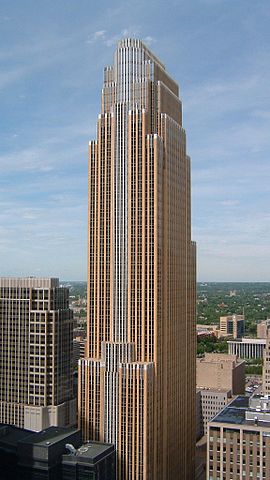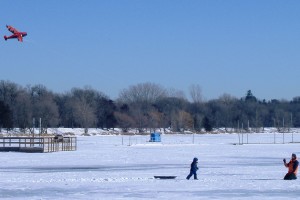[ When I wrote about there being social factors other than the cold keeping people from moving to Minneapolis, Sami Karam, a Lebanese immigrant who now lives in New York City and posts insightful demographic analysis as his site Populyst, mentioned that he’d had similar experiences trying to fit in there when he lived in Minneapolis in the 1980s. I asked him if he’d write up his experience, and he graciously agreed. While this story is about 30 years old, I believe it still holds relevance today. You can also follow Sami on twitter at @sami_karm – Aaron. ]
“For how much longer will you go by Sami instead of Sam or Samuel?… Because after a certain age, a Robby, for example, would revert to a more grown-up name like Bob or Rob or Robert”, I was once asked and informed by a man in Minneapolis. My answer that Sami is a real first name, albeit not necessarily one that I favored over its variants, did not seem to satisfy him.
A decade later, when I started working on Wall Street and heard a similar comment, I found that this reaction to ‘Sami’ was not unique to the midwest or to the less diverse non-coastal US but that it was instead emblematic of cultures that were somewhat insular. Minneapolis did feel insular when I lived there as a young immigrant in 1986-88.
When Aaron Renn recently suggested that I write about my experience there, I was not sure that I could do a fair job of it. Would I use a chronology, as in a fragment of biography? Would I showcase the 1987 Twins triumph at home in game 7 of the World Series? How would I insert my fast weekend escapes to New York or L.A. on discounted fares that I bought in bulk from People Express ($45 to New York)? And my slow other weekends spent alone writing computer code in the office because I had nothing better to do?
When undecided, use data! So in the end, I settled on five main data themes. Minneapolis in 1986 was 1) cold, 2) flat, 3) remote, 4) rich, and 5) very white. The first four are still true today.
But first a few general comments.
Minneapolis was (is) a great place in many ways. The people around me were unfailingly kind. I liked the city’s well-designed infrastructure and amenities and its perennial ambition to turn itself into something bigger and better. “It wants desperately to be New York”, a Minnesotan college friend had volunteered before I moved there.
But after living there for two years, I was dubious. I thought that Minneapolis, though known as the ‘Minneapple’, was very happy just being Minneapolis. Further, if I want to be lucid, these same unfailingly kind people did not seem all that interested in me. I was an oddity in a place that seemed perfectly content without too many oddities.
As to Minneapolis becoming bigger and better, the most visible of the city’s major improvements, for example Cesar Pelli’s stunning Norwest (now Wells Fargo) Center then under construction, seemed destined to remain off bounds for the likes of me. I projected, rightly or wrongly, that were I to stay, it would take me a very long time to penetrate the higher circles of local industry.

Norwest (now Wells Fargo) Center. Image via Wikipedia/Public Domain
On the whole, my time in Minneapolis was comfortable but not easy. Although I had already lived in many places away from home, I felt in this case an unfamiliar isolation that was heightened by the cold winters and by the city’s remote location deep into the northern plains.
Of little assistance to my outlook was the fact that I was reading, in the dead of winter, Roland Huntsford’s The Last Place on Earth, a chronicle of the 1911 two-team race to reach the South Pole. Would I sail through and emerge victorious like Amundsen? Or would I endure an exhausting slog only to then freeze to death like Scott? Neither, of course, though my February psychology was trending to Scott.
COLD
How bad is the weather in Minneapolis? Regarding the temperature, it is as cold as Anchorage in winter, but no worse than Chicago in spring, and similar to New York and Denver in the summer and fall. On the whole, I found it quite bearable, and even enjoyable, except for the most extreme days of winter.

There are other weather factors beside temperature. For one, Minneapolis enjoys an unusually high number of completely cloudless days. “It is too cold for the humidity to hold up in the air”, my recruiter had deadpanned during the first interview.

Minneapolis-St Paul (MSP) has more clear days than Chicago and more total sunny hours than New York, and far more than Seattle. Its annual snowfall is similar to Denver’s but Denver is even sunnier. Surprisingly, Denver has more clear days than Miami and as many sunny hours.
So in sum, Minneapolis is abysmally cold and snowy in winter. But overall, it is frequently sunny even in winter. If you prefer sunny cold days to tepid wet grey ones, you could argue that the weather in Minneapolis is in fact better than in Seattle. The temperatures in Seattle are less extreme and there is little snow. But the sky is frequently overcast and releases rain in forty more days every year than in Minneapolis.
FLAT
Minnesota has little variation in its land elevations and is the fifth flattest state in the US. Standing at any high point in the city, say on the tenth floor of a building, the view is unobstructed by natural topography in all directions. Except on hazy or foggy days, the towers of downtown are clearly visible from far away. In winter, the chill wind can do its work unbothered by natural obstacles and its steady sweep undulates drifts of snow from one side of the road to the other (‘snow snakes’, per one of my friends).

Lake Harriet in Winter by Amy Mingo. Licensed under CC BY 2.0
I once took a drive north to Duluth and pressed on along the north shore of Lake Superior. We encountered few hills until we reached the Sawtooth range of low mountains along the lake.
REMOTE
In my view, the most unique geographic feature of Minneapolis is not its weather, but the combination of its weather and its remoteness. It is very far from any other sizable city. Its own metro population has 3.6 million today, up from less than 2.5 million when I lived there. But the closest large city is Chicago, 409 miles away. That is the same distance as Boston to Baltimore, and 30 miles more than San Francisco to Los Angeles. Unlike on those trips however, there is little to break the monotony of a day-long trek through rural Wisconsin, except for a quick bypass of Madison and perhaps a lunch break at Wisconsin Dells.

On my first long drive to MSP, coming from Indiana, I was thrilled at dusk to finally reach Eau Claire because that meant that I only had… 90 miles to go to get to MSP.
Minneapolis is even more isolated to its west. Driving in that direction, the first city of over one million inhabitants is Seattle, 1,656 miles away. I never ventured in that direction. But I did head to Kansas City for New Year’s 1988. That was a mere 436 miles of driving through the frozen grey-brown fields of southern Minnesota, Iowa and Missouri. The city of Des Moines, helpfully located half way, was the only pretext to take a break.
The next large cities beyond Kansas City were Denver and Dallas-Fort Worth, both at over 900 miles from Minneapolis. But I never went there by road.
The brave that push northward from MSP into Canada will not encounter a sizable (say greater than 500,000) concentration of humans until Winnipeg in Manitoba, 460 miles away.
I wonder if MSP’s remoteness made it more insular back then. Today, people fly more easily and everything seems closer. But in 1986-88, I met some people in their 50s or 60s who had never left the state. In some cases, they were proud of it and intent on keeping it so until the end. There was no need to venture anywhere, other than for curiosity or a love of travel, especially when the local economy was doing so well.
RICH
Minneapolis-St Paul was quite content with its economy. Back then, it boasted higher median household income (MHI) than the US average. Today too, the MHI in Hennepin, Dakota, Ramsey, Anoka and Washington counties (the metro Minneapolis-St Paul area) is significantly higher than the national average, roughly in line with that of Manhattan.

Minnesota is home to corporate giants Cargill (agriculture, trading), Carlson (travel), United Health (health care), Target and Best Buy (retail) and others.
I saw first hand and was inspired by the Minnesota work ethic that seemed to strike just the right balance between personal ambition and team work. I was employed by an architecture-engineering design firm that had at the time its headquarters in Minneapolis and a small satellite office in Milwaukee. I had no doubt that it would grow smartly. Today it has eight offices coast to coast.
WHITE
When I lived there, Minneapolis’ ethnic makeup was over 80% white. Today, this percentage has dropped to the mid 60s. I am guessing that the new diversity has changed the character of the city and opened up new cultural vistas.
Someone like me would probably find it easier to integrate today than I did in the late 1980s and may more readily decide to settle in Minnesota for the long term. To be sure, it is still brutally cold. It is also still very far, but it may feel closer today thanks to easier travel and social media. The locals are probably more interested in the foreign-born today because there are more of them around. And they bring with them something new and interesting.
My guess overall is that Minneapolis is a much better place for an outsider today than thirty years ago, though still not as socially navigable as the traditionally more universal cities on either coast. Nonetheless, as I alluded above about Wall Street, coastal America seems more inclusive overall but it still comprises smaller sub-cultures that can be just as exclusionary as some midwestern cities. The outer walls are gone but smaller inner citadels remain off limits.
In 1986, as a Mediterranean in the land of the Scandinavian and German-American, I sought warmer personal connections. As luck would have it, baseball rescued me in the end. When the Twins made it to the 1987 World Series, a groundswell of camaraderie and good cheer spread through my entourage, one that was broad and generous enough to see me invited to several homes where I watched the games and liberally high-fived everybody. There was no going back to formality after that.
Forever etched in my memory is a night drive into downtown on the last day of the World Series. Every window of every building was lit up in tribute to the Twins victory and the entire city was glowing like a celebratory thank you to the heavens.
from Aaron M. Renn
http://www.urbanophile.com/2018/05/15/northern-ambition-young-and-foreign-in-the-twin-cities-circa-1987/
No comments:
Post a Comment